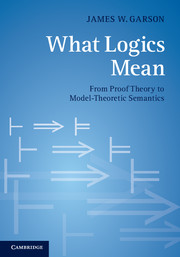Book contents
- Frontmatter
- Dedication
- Contents
- Preface
- Acknowledgements
- 1 Introduction to model-theoretic inferentialism
- 2 Deductive expression
- 3 Local expression
- 4 Global expression
- 5 Intuitionistic semantics
- 6 Conditionals
- 7 Disjunction
- 8 Negation
- 9 Supervaluations and natural semantics
- 10 Natural semantics for an open future
- 11 The expressive power of sequent calculi
- 12 Soundness and completeness for natural semantics
- 13 Connections with proof-theoretic semantics
- 14 Quantifiers
- 15 The natural semantics of vagueness (with Joshua D. K. Brown)
- 16 Modal logic
- Summary
- References
- Index
15 - The natural semantics of vagueness (with Joshua D. K. Brown)
Published online by Cambridge University Press: 05 June 2014
- Frontmatter
- Dedication
- Contents
- Preface
- Acknowledgements
- 1 Introduction to model-theoretic inferentialism
- 2 Deductive expression
- 3 Local expression
- 4 Global expression
- 5 Intuitionistic semantics
- 6 Conditionals
- 7 Disjunction
- 8 Negation
- 9 Supervaluations and natural semantics
- 10 Natural semantics for an open future
- 11 The expressive power of sequent calculi
- 12 Soundness and completeness for natural semantics
- 13 Connections with proof-theoretic semantics
- 14 Quantifiers
- 15 The natural semantics of vagueness (with Joshua D. K. Brown)
- 16 Modal logic
- Summary
- References
- Index
Summary
(This chapter draws heavily from Brown and Garson (in preparation).)
Timothy Williamson (1994, p. 142 and elsewhere) presents a number of powerful arguments against supervaluationist treatments of vagueness. In light of the failure of those and other accounts that do not preserve classical logic, Williamson concludes that the only tenable theory of vagueness is epistemic. His view adopts the counterintuitive thesis that there are facts of the matter as to whether a borderline case counts as (for example) being bald, and that our inability to decide such a case is simply the reflection of limitations in our knowledge of that reality.
This chapter shows that ‖QL‖, the natural semantics for classical predicate logic, provides a semantics for vagueness that preserves the core intuition behind supervaluationism, namely that some sentences are undecided in truth value (Section 15.2). However, ‖QL‖ faces none of the problems put forward by Williamson (Section 15.3). Once this alternative to supervaluations is in place, pressures for accepting an epistemological account of vagueness can be resisted (Section 15.4).
- Type
- Chapter
- Information
- What Logics MeanFrom Proof Theory to Model-Theoretic Semantics, pp. 244 - 254Publisher: Cambridge University PressPrint publication year: 2013



